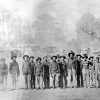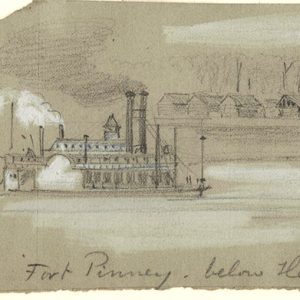calsfoundation@cals.org
Fort Pinney
Fort Pinney was one of several camps established in Phillips County during the Civil War to house formerly enslaved people and was the base for several expeditions into Mississippi.
More than 2,000 former slaves followed Major General Samuel Ryan Curtis’s Union Army of the Southwest when it occupied Helena (Phillips County) in July 1862, ending the Pea Ridge Campaign. Others soon followed, and several contraband camps were established to house them, though some were abandoned after being attacked by Confederate forces. By 1864, the primary camps in Phillips County were at Helena, Freedmen’s Fort, Island No. 63 on the Mississippi River, and Fort Pinney, located southeast of Helena in Lake Township across the river from Friars Point, Mississippi (sometimes rendered Friar’s Point in Civil War documents).
The date of Fort Pinney’s creation is unknown, but it was established prior to April 29, 1864, when a Union expedition from Helena stopped there on its way to Desha County. The first mention of the base in The War of the Rebellion (the compiled official records of the Civil War) was in an October 10, 1864, report from Brigadier General Napoleon Bonaparte Buford, who wrote that “Freedmen’s Fort and Fort Pinney are garrisoned by invalid troops, organized by Colonel [John] Eaton for special service, in guarding leased plantations. These men are unfit for service, old, diseased, unfit for soldiers, and indifferently officered.” Fort Pinney’s garrison would also include Black Union soldiers from the Fifty-sixth and Sixty-ninth United States Colored Troops.
The camp served as the base for at least two Union excursions into Mississippi: the December 19, 1864, expedition from Fort Pinney to Friar’s Point and the January 27, 1865, expedition from Fort Pinney to Kimball’s Plantation. It also served as a haven for several enslaved people freed during Colonel Charles Beltzoni’s February 1865 expedition from Helena to Friar’s Point, when Beltzoni reported that “4 men, 10 women, and 16 children, were transferred to the care of the commanding officer at Fort Pinney, as I had no subsistence for them.”
After the Civil War ended, many people remained at Fort Pinney, and in 1869 the Helena Weekly Clarion reported that if a school were established there it could serve 120 Black children; the school apparently never transpired. After a catastrophic levee breach at Fort Pinney in May 1874 “ruined 4000 acres, and as many prospective bales of cotton,” the community was evidently abandoned.
Investors from Memphis, Tennessee, apparently acquired the site and established the Westover plantation, managed by F. C. Stephenson, whose December 1878 letter to a Memphis newspaper is the first known mention of “Westover, Ark.” A post office was established there that year. Samuel Rembert purchased the plantation from J. C. Neely in early 1897 and appears to have owned it for several years.
The Westover post office was discontinued on May 15, 1905, and the mail was sent to Helena.
Westover’s fortunes waned in the twentieth century, and by 1922 the Arkansas Democrat described it and another nearby location as “mere boat landings.” A ferry between Westover and Friars Point operated for many years and was the scene of two tragedies. On December 3, 1929, the ferryboat Nancy F caught fire and sank, killing one crew member. On July 1940, a three-year-old child died when the car she was in crashed through the ferry’s railing.
In the fall of 1949, the U.S. Army Corps of Engineers announced a $133,640 plan to place 11,000 feet of revetment, grade the riverbanks, and sink articulated concrete mattresses at Westover and Helena in Arkansas and Burke Landing in Mississippi. The Westover revetment survives in the twenty-first century.
For additional information:
“Among the Farmers.” Helena Weekly World, January 13, 1897, p. 3.
“Arkansas Postal News.” Arkansas Democrat, April 26, 1905, p. 4.
Benj. Thomas to Capt. T. C. Meatyard, December 20, 1864, National Archives and Records Administration, Records of Named Departments, 393P2E299, Box 1.
“Break at Friars Point.” Memphis [Tennessee] Daily Appeal, May 14, 1874, p. 1.
Carmichael to Captain T. C. Meatyard, May 4, 1864. National Archives and Records Administration, Records of Named Departments, 393P2E299, Box 1.
“Check Sloughing of Big Mississippi Levee at Old Town.” Arkansas Democrat, April 13, 1922, p. 1.
“Child Carried to Death as Car Plunges in River.” Northwest Arkansas Times, July 30, 1940, p. 5.
“Getting After the Cotton Seed Association.” Daily Memphis [Tennessee] Avalanche, December 5, 1878, p. 2.
Helena Weekly Clarion, August 11, 1869, p. 3, col. 2.
“Miscellaneous.” Daily Memphis [Tennessee] Avalanche, May 16, 1874, p. 4.
“River Work Planned.” [Blytheville] Courier News, October 7, 1949, p. 10.
The War of the Rebellion: A Compilation of the Official Records of the Union and Confederate Armies, Series I, Vol. 48, part 1, pp. 73–74; pp. 120–121. Washington DC: Government Printing Office, 1896.
Mark K. Christ
Little Rock, Arkansas
 Civil War through Reconstruction, 1861 through 1874
Civil War through Reconstruction, 1861 through 1874 Military
Military Fort Pinney
Fort Pinney 



Comments
No comments on this entry yet.